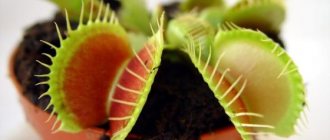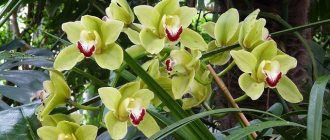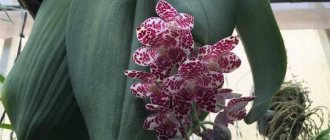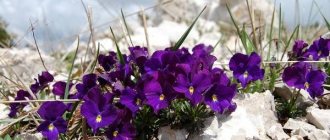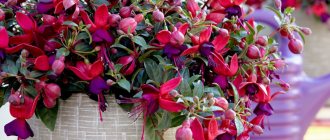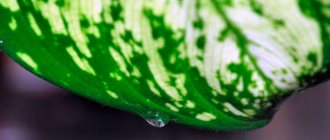Added 12/09/2013 orchids, exotics Reduce text size Increase text size Text size Print Send by mail
Determine your orchid's needs by its appearance!
Orchids have always attracted attention and excited the imagination of people.
Legends were formed about these plants, magical and medicinal properties were attributed to them, and they were passed down from generation to generation. The attractiveness of orchids can only be compared with the attractiveness of gold, and “orchid fever” appeared earlier than gold fever. Hundreds of orchid hunters went to the tropics to find and bring back exotic beauties. Now the “disease” has taken on other forms, and plants have become available to almost anyone. Butterfly orchids (phalaenopsis) can be seen in almost every flower shop; they are given as gifts or simply bought for yourself. Anyone can become the owner of an orchid!
Phalaenopsis (butterfly orchid)
It doesn’t matter how the orchid entered the house - bought out of pity at a discount, received as a gift, or you simply couldn’t pass by an unusual flower in the store, but the first delight passes, and a lot of questions about care arise after it. The first misconception immediately arises: the orchid is a capricious beauty that needs to be created in greenhouse conditions. But upon closer examination, it turns out that keeping an orchid indoors is much easier than some traditional plants.
Description
The classification of the family is basically based on the formation of the fused stamen and pistil (the so-called column), and the nature of the location of the anther and the upper part of the anther - the stigma.
Most orchid species grow in the tropical zone - and here they receive ideal conditions for development. And a characteristic feature of the distribution of orchids is precisely the diversity and originality of the flora of this family on different continents.
Of course, in temperate latitudes, orchids are less represented than in the tropics. For example, in temperate latitudes only 75 genera and 900 species are represented - only 10% of the total. In the southern temperate climate there are even fewer such plants. Only 419 species from the orchid family grow on the territory of our country.
Orchids in the temperate zone are represented by perennial terrestrial herbs that have underground (which is important for this family) rhizomes (tubers), but the tropics delight with epiphytic orchids.
The most popular varieties of orchids
The most popular varieties of orchids with photos and names are presented in this section. But, before you figure out the varieties, you should keep in mind that orchids are divided into the following categories:
- With bulbs. The bulb is a storage of nutrients, looks like a seal, which is often located at the bottom of the flower. This species includes: “Lelia”, “Oncidium”, “Miltonia”, “Cattleya”, “Dendrobium” and others.
- Sympoidal. This variety of orchids grows in bushes that have several shoots. The root system is located horizontally. This species includes the following varieties: “cattleya”, “cambria”, “oncidium”, “cymbidium”.
- Smelling. Flowers have a wide variety of aromas: from sharp to almost imperceptible.
- Rare. The rarity of the orchid family lies largely in the flowers, which can vary in size and color. Many flowers resemble birds.
- Rooms. A lot of indoor orchids were bred because they tried to make a home flower from an exotic plant. And I must say, it turned out pretty well. New varieties have taken root, although they require some attention.
We have also prepared a list for you, which is accompanied by pictures and descriptions for your convenience. Let's take a closer look at one of the most beautiful flowers.
- "Dendrobium". In nature, this variety of orchids grows on trees, often in trunks or branches. This flower is native to Australia, where forests and tropics are humid. Orchids of the genus Dendrobium are the most popular and number about 1,200 species. These plants are small in size and their flowers come in different shapes and colors. A distinctive feature of “dendrobium” is its shoots, which are slightly thickened and have a cylindrical shape.
- "Cymbidium". This genus of orchids can be found in flower arrangements, but the variety is rarely bred at home. The flower is easily recognized by its leaves, which are sword-shaped. The orchid peduncle is oblong and directed downwards. The flower is quite spreading, so at home it will take up a lot of space. Orchid flowers are small in size, and their colors can be very diverse.
- "Cattleya." The flower got its name in honor of the famous botanist William Cattleya. This variety of orchids also lives on tree trunks. This species has bulbs that are quite long and thickened in the middle part. The leaves are compacted and leathery, their length is relatively small - 30 centimeters. Flowers are a distinctive feature of this species. The flowers are very delicate, lilac in color, and the “lip” is bright purple. Their color range ranges from white to dark tones. This variety of orchids has a scent.
- "Blue", or "Phalaenopsis aphrodite - royal blue". A gorgeous representative of the orchid family (see photo). This hybrid was bred in Japan by crossing the “Asian Cammeline” and the “Phalaenopsis aphrodite”. Orchid flowers are not very large, only 5 centimeters, and the leaves of the flower are wide and fleshy. It is worth noting that this flower is difficult to buy; it can rarely be found in flower shops.
- "Miltonia" This representative of the orchid family is one of the most popular among gardeners. Many hybrids have been bred based on “Miltonia”. The leaves of this flower are large and oblong, and the flowers of this species have a scent, while some other varieties do not. A distinctive feature of "Miltonia" is its long flowering.
- "Black Orchid". This flower is considered rare. The origin of the “black orchid” is still not fully known, so it is difficult to say anything about it. However, all biologists and gardeners are eager to see a wonderful plant at least once. The peduncles of this species are oblong, but the leaves are short and dark.
- "Cambria". This hybrid was bred specifically for growing indoors. “Cambria” has such a difference as a spindle-shaped bulb, to which 2-3 dark-colored leaves are adjacent. Peduncles grow from the bulb, usually one or two shoots. The flowers are yellow with red or dark red specks. After the bulb has faded, it should be removed to allow new flower stalks to form. If you care for Cambria correctly, it can delight you with flowering all year round.
- "Wanda." This is a bush representative of the orchid family. It is distinguished by its large size. The stem of “Vanda” is large, the leaves are xiphoid and oblong, and the peduncle is large. There are purple (different shades), pink, orange, red and white flowers.
- "Yellow Orchid" This indoor hybrid was bred specifically for living and breeding at home. The flower is small in size, has one stem and large fleshy leaves. The flowers are very delicate and beautiful, with a light aroma.
- "Phalaenopsis mini". Based on the name, it becomes clear that the flower is small in size, which is why it is loved by many. This variety produces one or two peduncles on which many flowers bloom. The leaves of this orchid are small, as is the flower itself.
- "Dracula". A very interesting name and no less remarkable appearance of the flower. The peduncles of this species are large and look like “dragon’s mouth”.
- "Bulbophyllum". The largest variety of orchids in terms of its number, which includes about 2 thousand subspecies. The leaves are large, fleshy, green.
- "Aganasia". The distinctive feature of this flower is its flowers and leaves, the latter having the shape of an ellipse. Flowers grow on the peduncle (without scent), which are shaped like stars. The base of the orchid is covered with small scales.
- "Angrekum". This variety of orchids has a rather unusual type of branching (see photo). The flowers are star-shaped and quite large in size. It is worth knowing that some types of these flowers are not suitable for growing at home.
- "Beallara." This hybrid was obtained by crossing four species - “Brassia”, “Cochlyodes”, “Miltonia”, “Onotoglossum”. The stems of "beallara" are dense, the leaves are elongated, with a clear vein in the center. The flowers bloom in the shape of stars and have a pleasant aroma.
- "Brassavola". This variety was named after the Venetian botanist Antonio Brassavola. This variety of orchids has fleshy leaves that are formed from a cylindrical bulb. Peduncles are long, with flowers at the end. It is worth knowing that this variety has an aroma that can only be felt at night.
- "Brassia". It is distinguished by large bulbs. The leaves are green and large. The main feature of this flower is its ability to bloom all year round.
- "Grammatophyllum". This representative of orchids is one of the tallest of its kind and can reach 60 centimeters. The bulbs of the plant are large; light yellow flowers with brown spots grow on the peduncles.
- "Zygopetalum". This variety of orchids grows in a ladder, forming creeping shoots. Young bulbs grow slightly higher than the base of the previous one, which allows the formation of a flower of an unusual shape. Zygopetalum looks very impressive in pots. The flowers are quite large, with a delicate and pleasant aroma.
- "Katasetum." A very beautiful and original variety, which includes about 150 species. The shoots are small and adhere to the soil surface. The bulbs are oval, the leaves are pointed, with longitudinal veins.
- "Ludisia" or "precious orchid". This variety is distinguished by small, rather small, flowers. They don't look as impressive as the big ones, but scattering them looks beautiful. A special feature of “ludisia” is its soft, even velvety leaves.
- "Miltassia" is a hybrid of "Brassia" and "Miltonia", which was identified as a separate genus only in the mid-nineteenth century. This flower is very difficult to confuse with any other species. The flowers are star-shaped, the petals are slightly elongated. The bulbs are flattened and slightly elongated. During the flowering period, an orchid can produce several flower stalks at once.
- "Oncidium" or "dancing dolls". The flower is characterized by long flowering. The flowers are small, lemon-red in color, although sometimes you can find a coral color.
- "Celogina" is a fairly wide variety of flowers. This variety of orchids is distinguished by soft white or green flowers, which have a “lip” of contrasting color.
- "The Emperor's Pearl" This flower is quite large and has lush blooms. The leaves of this variety of orchids are fleshy, dense, oblong and green in color.
In this list we talked about the most popular varieties of the orchid family. They are all beautiful, each flower is individual, has its own unique structure and flowering. Orchids are special flowers and require attention. At the same time, care is required not only for the flower, but also for the leaves.
Structure
The orchid family has a significant difference from all the usual flowering plants: we are talking about the fusion of filaments of stamens (there can be several of them - from one to three) with a style of gynicea. This fusion is called gynostemium or column - and, in addition to orchids, such a device is found only in Rafflesiaceae.
The orchid flowers themselves are usually collected in racemes or spikelets, much less often they are located alone (for example, lady’s slipper). Usually the flowers are three-membered, decorated with identical sepals. Of the three petals, the upper one forms the so-called lip - a kind of long outgrowth back, with nectar. And, since the downward position with this very lip is optimal for pollination, most orchids are faced with the process of resupination, or twisting.
Is it possible to keep an orchid at home?
Feng Shui teaching strongly discourages keeping orchids
in residential areas. This is justified by the fact that the flower is an epiphyte. It does not need soil to grow; the roots suck the necessary moisture and nutrients from the air.
Interesting materials:
What program to format a flash drive? What program should I use to view the hardware? What program to check hdd? What program to check the temperature of the video card? What program should I use to check my hard drive? What program to shoot games with? Which program should replace Adobe Flash Player? What program should I use to burn an ISO image to disk? What program to record games on PC? What type of graphics is used in Adobe Photoshop?
Characteristics and Features
Among orchids, perennial herbs occupy a large distribution and dominant positions, although sometimes shrubs and even large vines are found among them.
Typically, in greenhouse conditions, tropical species of this family live to a serious age - about 70 years.
Along with autotrophic forms, saprophytes are also found in orchids. And according to the nature of the substrate, it is customary to distinguish between epiphytes - the largest group, as well as lithophytes and terrestrials, distributed mainly in temperate latitudes. Epiphytic orchids usually develop large aerial root systems that have no hairs but are characterized by a special absorptive tissue called velamen. Moreover, in some of them, the roots take over the function of photosynthesis instead of leaves.
How to care for indoor flowers?
How to care for indoor flowers at home? If you think this is difficult, then you are mistaken. Fortunately, regardless of the variety or type, caring for orchids is the same.
After purchasing a flower, it needs to find a place in the house. But first of all, the plant should be put in “quarantine”. It sounds terrible, but it is necessary. The thing is that when buying, you may not notice that the flower is sick with something or that small pests live on it that can infect healthy flowers. After purchasing, place the orchid in a place where there are no other plants and watch it for a week or two. If everything is fine with the flower, you can move it to a permanent place. It is also necessary to take care of the conditions that need to be created for the flower to function normally.
- The first thing you should pay attention to is watering, since the flowering of the plant depends on this. Watering should be moderate. Orchids like moist soil, not soggy soil, so water only when the soil begins to dry out. Irrigation using the immersion method is considered optimal. But after this it is very important to remove excess moisture from the pan. Water for irrigation must be settled or purified. In addition, it should not be cold, as the roots may get sick.
- Temperature is the second point that should also be paid attention to. During the day in the warm season, the temperature can be 17-20 degrees. At night, the readings should decrease by 4 degrees.
- Humidity plays an important role in the life of the flower and leaves. The optimal humidity percentage for orchids is 60-70%. If you have dry air in your apartment, then you can put a humidifier in the room where the orchid is located. Ventilation will also not be superfluous.
- Substrate is another important factor. In the store, the flower grows in classic soil, which is intended for orchids, but at home you can prepare the soil yourself. It may consist of expanded clay, sphagnum (moss), fine oak or pine bark and charcoal.
- Feeding. At certain stages, the flower must be fertilized. Mineral fertilizers that contain phosphorus, nitrogen and iron are well suited. This composition stimulates leaf growth and also strengthens the flower’s immune system.
- Transfer. Do not disturb the orchid too often. Usually the plant is replanted once every 2 years. But nevertheless, this must be done, because after two years there are no more useful substances left in the soil, air circulation slows down and the roots breathe poorly, which can lead to flower disease. Select a pot that will be slightly larger than the previous one. However, keep in mind that a blooming orchid cannot be replanted.
Another important factor in caring for the orchid family is reproduction. At home you can use the following methods:
- peduncle (this method is one of the simplest and is suitable for phalaenopsis orchids);
- children (for children to appear, very high temperature and humidity are required);
- It is better to propagate by cuttings in the spring (this propagation method is suitable for such orchids as “Vanda”, “Dendrobium”, “Epidendrum”);
- by dividing the bush (only an adult bush is divided, and at least three bulbs should remain on each of the divisions);
- seeds (this method is considered the most difficult, as it rarely gives good results).
Caring for orchids is not difficult, but it is important to control watering and humidity. Because of this, the orchid is considered a whimsical flower, since it is not always possible to create an optimal level of moisture, and the temperature difference that the plant requires is completely impossible in some regions of the Russian Federation. But if you try, you can achieve annual flowering.
There are incredibly many varieties of orchids; it is difficult to list all the types and varieties. But we can say with confidence that this is a unique flower, with everything special: flowers, leaves, and root system. We have also prepared a video for you that describes popular varieties of orchids, some of which we mentioned in the article. The video also draws attention to important factors that should be considered when caring for orchids.
Plant care
Orchid is one of the few indoor flowers that can adapt to any conditions around it. On the other hand, hybrid varieties, of which more than 250,000 have been bred today, tend to be more prone to greenhouse conditions, very reminiscent of the tropics they are accustomed to.
Orchids always strive for light. For them, the sun's rays are the basis of a normal life. If there is not enough light, then the plants sometimes don’t even bloom at all.
But it is important to remember that in summer the sun is too aggressive, so the plant needs to be shaded or placed in a place where there will be more diffused, soft light, but not direct sunlight.
But in autumn, winter and spring the flower can be placed on the windowsill. However, during flowering, in autumn or spring, artificial additional lighting may be required.
Unusual varieties
The largest orchid flower ever recorded in size was found in the 19th century in what is now Indonesia, with petals reaching almost a meter in length.
Among the unusual species of orchids, the most fascinating with the pretentiousness and luxurious appearance of their flowers, is, for example, the monkey orchid , in the outlines of the flowers of which it is easy to see the faces of monkeys (associations with monkeys or marmosets usually come to mind). Another example is the Italian orchis, whose petal-lip shape resembles the silhouette of a human figure.
In the photo below you can see what orchids look like when grown at home:
These photographs show orchids in the wild:
Why doesn't the orchid grow?
Make sure you have the proper growing conditions! Perhaps you simply flooded the pot with the plant, or you placed the container with the orchid on a window that is too sunny. Another reason is the very small container in which the flower grows and an ill-constructed substrate: the roots of the orchid need space and a lot of air. Heavy soil is absolutely not suitable for this beauty!
Orchids of the genus Dracula (Dracula simia)
Botanical classification of orchids
The American scientist Dressler divided the many-thousand-strong plant family of orchids into several subfamilies:
- Orchids (orchids). Includes more than 200 genera and even more subspecies. These are perennials that grow on the ground, with an erect stem. The most famous of them are Phalaenopsis, Dactylorhiza and Anacamptis with large spike-shaped inflorescences.
- Epidendral. Includes more than 20 thousand subspecies of perennials, which in the wild are found in the subtropics, tropics and temperate latitudes. The most striking representatives of this subfamily are Dactylostalix, listed in the Red Book, as well as Cattleya, noticeable for its large bright flowers.
Why doesn't the orchid bloom?
In any case, this beauty refuses to bloom due to the poor conditions of its detention. The absence of flowers can be caused by excessively dry or very humid air, the temperature of the flower below 22-25 degrees, lack of sunlight, or, on the contrary, a too “hot and sunny” window sill.
Phalaenopsis orchid flower
How to save an orchid?
Many people ask this question. To do this, do not allow the orchid to overheat and burn under the scorching rays of the sun, do not place the container with the orchid in winter next to heating devices that dry out the air, do not moisten the soil in the pot unless clearly necessary, and do not “catch a cold” of the heat-loving beauty while ventilating the room in a cold environment. season.
The meaning of different shades
All Orchids symbolize love and beauty, but the colors of their buds can change the meaning of that plant. And stunning exotic flowers and equally beautiful bouquets make them an ideal gift for your loved ones
.
- Blue . A very rare shade, blue Orchid symbolizes spirituality and contemplation. This rare flower is an ideal gift for a mother or lover.
- Red . The language of red buds speaks either of passion and desire, or of strength and courage.
- Pink . Such buds signify innocence, femininity and admiration. A great gift for your beloved friend.
- White . White flowers represent reverence and humility, innocence and purity. They are an ideal amulet for mothers at the birth of a child.
- Violet . This color symbolizes admiration, respect and dignity. Such a bouquet is a great way to express your respect and admiration for a person.
- Yellow . Yellow flowers bring friendship, joy and new beginnings. A yellow bouquet of Orchids is ideal as a gift to a friend for some achievement.
- Orange . Flowers carry the energy of enthusiasm, courage and pride. Such a bouquet will help you take a responsible step towards the unknown.
- Green . Green Orchids are believed to bring happiness and good luck to the home. It is a symbol of health, life, nature and longevity.
Planting orchids at home
Surprisingly, contrary to the established belief that an indoor flower should grow in a pot of soil, orchids prefer to “live” in a container with a substrate made of bark, sand, forest moss, peat and even polystyrene foam. You can buy ready-made soil for orchids, or make it yourself.
The bark is usually taken from pine and always from a “dead” tree. It is crushed, boiled in water and dried. Only the upper green part of the moss is used, after washing it with boiling water and shredding it. Sand for the substrate – only coarse sand. You can also add charcoal, foam chips and fine expanded clay to the mixture. The components are mixed and thoroughly moistened immediately before planting the orchid.
Frosty Bulbophyllum (lat. Bulbophyllum frostii)
By the way, when choosing a pot for an orchid, choose pots made of white or other light plastic: they will bask less in the sun. Wicker baskets or flowerpots are perfect for planting orchids.
The plant must be planted as carefully as possible so as not to damage the rather fragile roots of the orchid. The substrate should not be compacted - just fill the voids around the rhizome of the flower with it.
Useful properties and uses of orchids
In addition to exceptional decorative properties, some types of orchids have valuable beneficial properties that are widely used in folk and traditional medicine.
Tubers of certain types of orchids contain a large amount of mucus, rich in antiseptics and immunoglobulins, as well as starch and protein. A decoction of the roots of Lyubka bifolia (lat. Platanthera bifolia) is used for indigestion, inflammation of the bladder, as an analgesic and antiseptic.
Lyubka bifolia (lat. Platanthera bifolia)
The roots of the Cremastra appendiculata orchid are used as an analgesic and antidote for poisonous snake bites.
Dendrobium nobile or noble (Dendrobium nobile) is used for gastrointestinal diseases, pain syndromes and as an aphrodisiac.
Calanthe triplicata is used to treat diarrhea, relieve swelling and various types of pain.
Anectochilus regalis is a rare epiphytic orchid from which valuable medicinal oils are obtained.
Ophrys bee-bearing
Ophrys bee-bearing (lat. Ophrys apifera)
Why does an orchid fall off?
There are many reasons for orchid buds or flowers to fall off. Lack of light, draft, heat or cold, dry air in the room, stress as a result of the plant “moving” to another place, incorrect watering regime. In all these cases, the orchid gets sick and drops its luxurious flowers, and sometimes even leaves.
Anguloa uniflora
Natural hybrids
In nature, most orchids are pure species, without genetic impurities. But under natural conditions, hybrids can also appear, only without human participation. This happens quite rarely, and the newly-minted hybrid is usually the “fruit of love” of 2 related species.
Example: natural hybrid
Cattleya x hardyana
appeared as a result of crossing Cattleya dowiana var. aurea x Cattleya warscewiczii.
Please note that the second word in the name is written with a small letter, as in the case of species orchids, but it is preceded by an “x” sign (a sign of hybrid origin). Also, there is no space between the x and the second word.
There are names of natural hybrids that coincide with the names of species orchids.
Example:
• Cattleya xdolosa = Cattleya Loddigesii x Cattleya walkeriana – a natural hybrid • Cattleya dolosa – an independent species of orha
Sometimes natural hybrids are written as follows: the “cross” is removed and the second word in the name is written with a capital letter so as not to confuse it with the species. But this can be misleading, since the name then takes on the appearance of an artificial hybrid (see above).
Very often, companies selling orchids don’t bother with crosses and write that way.
Example: Cattleya xdolosa becomes Cattleya Dolosa.
Download: Appendix “List of Hybrid Orchids”
Author: Irina Baltaga Updated: March 31, 2020
- All about orchids
Geography of growth
As indoor plants, they are distributed throughout the world. Orchids require the creation of conditions close to their natural environment. Wild species are mostly concentrated on continents with tropical and subtropical climates (Bolivia, some regions of Brazil, Indonesia, southern India, northeastern China). The climate of these regions is characterized by high humidity and a short dry season. Such conditions are ideal for all varieties of epiphytic orchids.
Countries with a temperate climate zone (North America, Ecuador, Colombia) are good for growing about a thousand species of orchids. In these areas, plants grow in the traditional way - on the surface of the soil and have underground roots.
In central Russia there are approximately 400 species of wild orchids.
What does the flower symbolize?
The orchid has been held in high esteem since ancient times. For different peoples it symbolizes:
- Love;
- beauty;
- wealth;
- sophistication;
- thoughtfulness;
- Charm.
The ancient Greeks considered this plant a symbol of masculinity . In fact, they were so convinced of the connection between Orchids and fertility that they believed that flowers with large tubers were boys and those with small tubers were girls.
The smell of vanilla accompanies flowering. Photo used as illustration. Source: Yandex.Images
The Aztecs mixed Vanilla Orchid with chocolate. They made a delicious elixir, which was endowed with magical properties that strengthened strength and spirit . And the Victorians collected these flowers to demonstrate luxury and refined taste.


